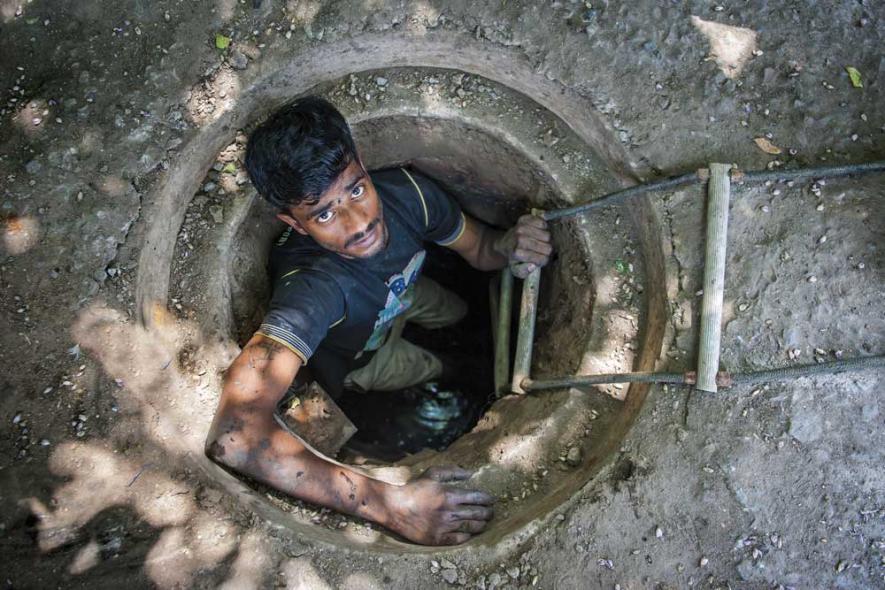Delhi Government Finds Only 32 Manual Scavengers in Its Latest Survey

A manual scavenger in Delhi. Image Courtesy: Barcroft India
After consistently denying the existence of the practice of manual scavenging and declaring its complete obliteration from the national capital, the Aam Aadmi Party (AAP) government has finally come out with a list of manual scavengers on Monday. However, this list has recorded only 32 manual scavengers in the national capital.
The list invalidates the claims of the civic bodies that the practice does not exist in the city. The decision to conduct the survey was taken earlier this year after reports of deaths of over 31 workers in the last seven years created pressure on the government.
However, the survey cannot be seen as a giant progressive leap, as the statistics have purportedly underrepresented the data. The National Crime Records Bureau (NCRB) data from 2015 also claims that there has been no death caused during manual scavenging. There is no government record tracking the workers that were hired for cleaning sewers by the contractors.
As a part of the Swachh Bharat Mission, the central government had also initiated a nationwide survey of the manual scavengers in January this year. The first phase (ongoing) involved counting those who clean night soil (buckets and cesspools in which excreta is collected overnight) and pit latrines in 164 districts across five states. The second phase will consider people who clean septic tanks, sewers and railway tracks. On July 31, the Ministry of Social Justice and Empowerment informed the Lok Sabha that 13 states have identified 13,657 manual scavengers until June 30, 2018. However, Delhi did not feature on this list.
The latest survey undertaken by the AAP government took into account district magistrates of 11 of the Delhi’s revenue districts. Apart from the East and the Northeast, the other districts reported no manual scavengers in their respective jurisdictions.
However, it is important to understand the flawed methodology through which these results were achieved. Speaking to Newsclick, Magsaysay award winner and Safai Karamchari Andolan activist Bezwada Wilson explained the problems in the process. “Over the years the government has failed to even recognise manual scavengers as workers, and now when they do this, the results of the survey are disappointing as they are far from reality,” he said.
When the government initiates the count, it requires the district collectors to organise a camp, wherein the manual scavengers are required to register themselves. In the past, it has been seen that the district collectors have brazenly denied the prevalence of the practice in their villages to show a good track record. The single camps organised in larger districts are also not accessible by scavengers, as it requires them to bear transportation costs. A major facet of manual scavenging gets completely ignored in such surveys – the gender of the manual scavengers. Previous reports have shown that over 90 per cent of the workers employed in manual scavenging are women. Due to the casteist and gendered nature of oppression they suffer at the hands of the contractors and the men in the field, they fail to register themselves at these counting camps. The survey officials often parachute into the districts, not taking into account these ground realities. Wilson adds, “There is a strong sense of stigma on the ground, and people do not wish to go to these camps as they fear losing their only livelihood, in the absence of alternatives.”
According to a report by The Indian Express, Delhi Social Welfare Minister Rajendra Pal Gautam admitted the limitations of the survey, and stated that it may not have accurately captured the prevalence of the practice. However, to truly capture the extent of the oppressive practice, the state needs to end its fixation on numbers and go beyond recognising manual scavenging as not only a health and sanitation concern, but also a social exclusion issue. Explaining this, Professor of social exclusion from Delhi University, N. Sukumar stated, “India will be truly clean when the prime minister cleans his own toilet. The issue is that we let this practice prevail as we know someone will do the dirty job for us.”
The oppressive nature of manual scavenging finds its roots in the institution of caste. The practice of manual scavenging was banned in India in 1993; however, the Prohibition of Employment as Manual Scavengers and their Rehabilitation Act was brought into force only in 2013. The fundamental loopholes in the approach towards manual scavenging can be rectified only when the issue is understood beyond numbers, and recognised as one that systemically dehumanises a stratum of the society.
Get the latest reports & analysis with people's perspective on Protests, movements & deep analytical videos, discussions of the current affairs in your Telegram app. Subscribe to NewsClick's Telegram channel & get Real-Time updates on stories, as they get published on our website.
























